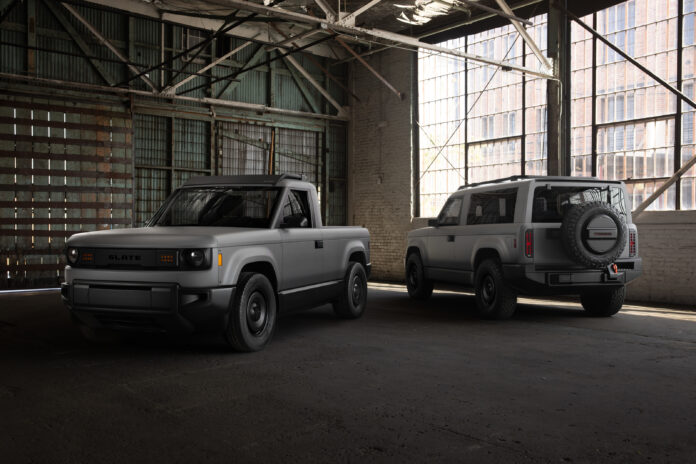There’s a deliberate design simplicity to electric truck start-up company Slate, which is hoping to fill a gap in the American EV market for something environmentally conscious and affordable.
(Image credit: Slate)
Starting at $20,000 for an unpainted ‘blank slate’ vehicle – which explains the brand’s name – the idea is to offer customers the chance to customise via a huge selection of flatpack accessories that can turn the basic and small, 4434mm (or 174.6-inch)-long two-seat pick-up into a more spacious five-seat boxy or fastback SUV, while also offering a selection of vinyl wrap kits easy enough for buyers to DIY-apply to personalise each vehicle’s look.
(Image credit: Slate)
But the vision remains simple, robust and low-cost. Steel rather than fancy alloy wheels sit under the body, manually wound windows substitute for electric-powered ones and the infotainment screen is the customer’s smartphone, universal mount and USB port.
(Image credit: Slate)
The standard 52.7kWh battery pack and 150kW rear-wheel drive electric powertrain should be good for 150 miles before recharging. But an 84.3kWh battery pack accessory can provide up to 240 miles. There’s no scrimping on safety though, with active emergency braking, forward collision warning and up to eight airbags.
(Image credit: Slate)
First deliveries of the Indiana, US-made full-electric truck are due at the end of 2026 and Amazon’s Jeff Bezos is one of the start-up’s big name backers, but meantime, Wallpaper* had a chat with Slate’s head of design Tisha Johnson – a former Volvo veteran, who has also worked for Polestar, Herman Miller and Whirlpool – on what’s driving her team forward to make this affordable dream happen.
(Image credit: Car Design Event, Munich 2025)
Wallpaper*: What attracted you to Slate?
Tisha Johnson: I had gotten to a point where I was more reflective about my path as a designer and what I had wanted to accomplish when in design school. There was this cornerstone of why I had become a designer in the first place: to deliver an affordable vehicle to a market that wasn’t addressed.
My student contemporaries would often focus on luxury or premium offerings, but what affordable cars have done for people’s lives is super meaningful, yet they’re not readily available, certainly not in the US. In my career I really hadn’t addressed this important topic so when I found out about Slate asking these big questions it was just something I had to do.
(Image credit: Slate)
W*: What sort of designers are working on the project?
TJ: Slate had fewer than 20 employees when I joined in December 2022. Now we have several hundred, but still just a handful of designers, who came primarily from the automotive industry, including Rivian and Ford.
(Image credit: Slate)
W*: How are you able to offer the low $20,000 starting price?
TJ: Slate’s manufacturing process is about simplification, reducing complexity and, where we can, leveraging off-the-shelf (parts) but always thinking about affordability with high desirability. We saw it would make sense to ‘delete’ a paint factory so that’s a massive cost reduction.
W*: What is your bodywork made of?
TJ: The vehicle is not formed of steel panels but plastic polycarbonate which is injection-moulded and able to have colour embedded.
(Image credit: Slate)
(Image credit: Slate)
W*: How are you helping customers wanting different exteriors?
TJ: With injection-moulded parts it becomes significantly easier to create ‘coach lines’ around the vehicle. We create patterns and cut wraps to pre-fit shapes that work on our car using these ‘coach lines’ because they are an enabler for a better outcome for somebody who’s never wrapped a car before. We apply that kind of thinking all over.
(Image credit: Slate)
W*: Will you have approved people to fit accessories too?
TJ: The car is DIY-friendly. But if you don’t want to do it, we’ll have a network of service providers. And it’s not just vinyl wraps, there are a ton of accessories. As an example, the SUV kit has a rear bench so the vehicle can go from a two-seater to a five-seater. Or it can become a people mover with an SUV top.
(Image credit: Slate)
W*: What stage is the vehicle’s development now?
TJ: We’re in the prototype phase and early pre-production. We’re working to get to the end of 2026 to have our first car rolling off the line.
W*: How will you sell the car?
TJ: Direct to the consumer, super simple. There’s no unique model. We want the process to be straightforward for people to own for a long time and continue to personalise to keep special.
(Image credit: Slate)
(Image credit: Slate)
Slate.auto, @slateauto


